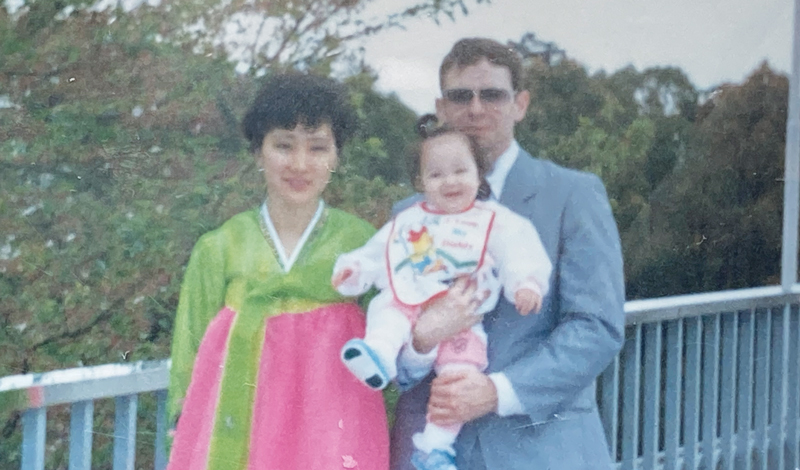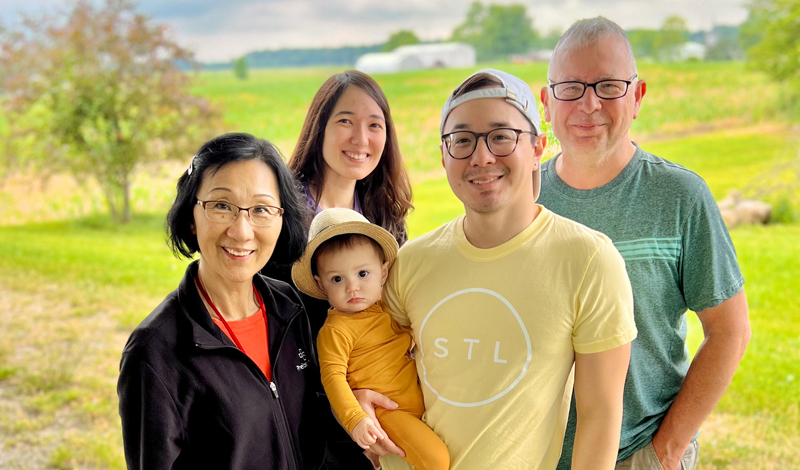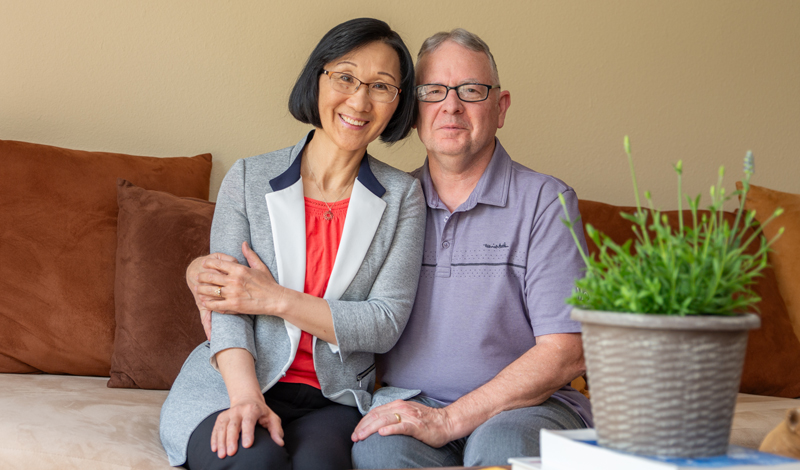Living Buddhism: An impossible tale drew your grandmother to her first Soka Gakkai discussion meeting in South Korea in the winter of 1972. Someone, she’d overheard, had recovered from leprosy, the illness afflicting her son, your father. This person, so the story went, had chanted Nam-myoho-renge-kyo to regain their full health and had done so.
Wonsin Fisher: Yes. In the ’60s and early ’70s, leprosy was considered incurable by many in South Korea. Lepers were usually cast out of society and could be seen roaming the countryside begging for alms. I remember rumors passed among children that such people were kidnappers and thieves. I winced whenever this was said but kept my opinions to myself.
Since before I was born, my mother and grandmother took care of all of us—my father, my younger siblings and me. We lived on a rice field rented with our labor, in a village where everyone did the same, where everyone was poor. My father never went outside, ever. If asked, we were not to say whether he was or wasn’t home. If company arrived at the gate, he’d be hidden in the attic before welcoming anyone inside.
But soon your grandmother came home with a bunch of Buddhists in tow.
Wonsin: The first time she did, I was convinced they were doctors, simply because they had come to see my father and we did not hide him from them. The only other person of whom this could be said was the country doctor. They were free of any stigmas, it seemed. Maybe it was because they were Koreans practicing a Buddhism that had come from Japan, a country held in contempt by Koreans for its decades-long occupation.
I’d have many opportunities to meet them. They came by often to chant with and check up on my father. They’d have long discussions about the meaning of the Lotus Sutra and its many chapters. I’d listen in wonder at the tale of the wealthy man and his children in his burning house, of an enormous treasure tower emerging from the earth. Are they talking about once-upon-a-time stories? I didn’t know. But what I did know, what I couldn’t miss, was that my father was regaining his vitality.
After a few months, his sores showed noticeable improvement. He was up and about the house, moving with less pain and greater purpose. He was more talkative and more hopeful. At six months, he stepped out into the open air to join my mother in the field to harvest the rice. I remember watching them and blinking in astonishment: my mother happy, my father healthy, working side by side in the open air and sunshine.
Father should be up in the attic, I remember thinking. Deep appreciation welled up in my heart, followed by another thought: I will never quit this Buddhism.
News of his recovery traveled throughout the village, and even the surrounding villages, and one day that summer drew over 100 to our home—far more than could fit in our living room. They’d come to chant, some for sick family members, others for other things. We rolled out a huge straw mat in the yard for them to sit.
Soon my father was walking freely around town, no longer contagious, his sores completely healed, shocking people who hadn’t seen him in years.
When he saw them, he told them his story, about the wonderful healing powers he’d brought forth from within his own life, an inner strength activated by chanting with deep faith in Nam-myoho-renge-kyo. My father’s illness opened the way for my entire family to encounter this Buddhism. Later in life, I became a nurse and worked closely with sick people. The lesson of my father’s recovery remained with me.
You met your husband, Mark, in 1986, while he was deployed to South Korea with the U.S. Army. You moved to the U.S. soon after, pursuing your nursing degree in 1997.
Wonsin: Yes. After raising our two children for a few years, I decided to pursue my GED certificate, then nursing school. The language barrier posed a major challenge. There were moments I thought I should give up, but in such moments, I would think to myself: Soon my children will enter school. If I give up now, what will I tell them when they encounter challenges there? This thought and another kept me going: I’m doing this for something bigger than myself. When I graduate, I’ll use my nursing degree to advance kosen-rufu in America.
In 2001, I graduated nursing school and began working as a nurse. Of course, the patients I encountered were struggling with more than the illness itself—they often arrived hopeless, resigned and afraid.
As I treated my patients’ symptoms, I began noticing some alarming symptoms of my own. I was becoming forgetful, losing my keys, locking myself out of the house, leaving a patient’s room and forgetting immediately where I’d been. I began running into walls, something my husband teased me about but was quite alarming to me.
Then, in 2007, a back injury triggered sudden, body-wide weakness. Almost overnight, I lost all strength. Combing my hair became difficult. Even opening the fridge, something a determined 3-year-old could manage, took many attempts. I began seeing doctors, one after another, in search of a diagnosis, but all of them shook their heads, suggesting anxiety meds for what they supposed was a psychological issue. I didn’t have anxiety, though.
I chanted to find the best doctor, a diagnosis that fit my symptoms and the treatment necessary. In February 2009, I was diagnosed with chronic Lyme disease, an illness that isn’t recognized by the medical establishment and for which treatment is difficult to pursue.
I kept working, doing light paperwork and training the freshly hired nurses—swift, intelligent young women who were put under my charge for any physical work that needed doing. A month prior to my diagnosis, I felt so weak and frankly, so hopeless. When my husband asked if I was planning to go to that year’s Korean-language conference at the SGI-USA Florida Nature and Culture Center, I asked him why. “Why go,” I asked, “when I might be dead in a month, two months, a year?” But he and others urged me to go and to win. I remember waking the first morning there and discovering the strangest thing: I wasn’t in any pain at all.
That day, riding a bike along Toda Lake, a woman biking in front of me fell and injured herself. I went to her right away and called for the medic. I went with her to the hospital and stayed by her side through the night, updating everyone on her condition. It was very strange—I was up all night, alert, pain-free, chanting Nam-myoho-renge-kyo for the recovery of a member. After months of chronic pain and fatigue, I’d tapped new strength. Wow, I thought, I’ve got to awaken to my mission to support others. My life has a capacity that I had forgotten.

That must have been incredible to discover. What happened then?
Wonsin: I returned to work with a different state of mind, determined to use my own struggle with illness to encourage others and share Nam-myoho-renge-kyo with them. Chanting, I was struck by a thought that came again and again: Nam-myoho-renge-kyo is the best medicine. And chanting, I realized that I’d been going about my work all wrong: as a nurse who practices Buddhism, rather than a Bodhisattva of the Earth living out her vow as a nurse.
My lifeline at this time was Ikeda Sensei’s guidance and the writings of Nichiren Daishonin. At work, I began to encounter people who were truly struggling. Many times, such people’s hearts are closed, but I tried to find a way, any way, to reach them. Each time I encouraged someone, I felt more hopeful myself.
“What is it that you’re really afraid of?” I’d ask them. “Death,” one woman told me. She was terrified that hell awaited her after she died. I asked her if I could share my own belief. Life, I said, fulfills a cycle, like the seasons fulfill a year. Our bodies grow old and tired. Just as a car’s parts become worn with age, returned to the manufacturer and recycled into a new car, this life, too, would return again as new life, a new journey. She was relieved by this, and I went to her many times before she died, reminding her of this and putting her at ease.
In 2012, I met a young man, 25 years old, who was seriously ill with diabetes. He had many dreams and listed them for me, one by one. He wanted to feel hopeful, to meet thousands of people, to have a best friend, to ride a bicycle. “I would do anything for those things,” he said. “Anything?” I asked. “Then why don’t you try chanting Nam-myoho-renge-kyo?”
Over the next six months, he began to chant and came to meeting after meeting, where he met many people, among them a young man who became his best friend. He bought a bike and, to everyone’s surprise, began to ride it around town. He came with us to a parade and rode on the SGI’s float that won first prize. There he waved to thousands of people, and they waved back.
“Are you happy?” I shouted to him over the noise. “Yes!” he said, “so happy!”
Before he passed away that summer, he fulfilled every one of his dreams. By this time, I had left my job to focus on my health and worked to build a thriving kosen-rufu district. For many months, I chanted to eradicate my Lyme disease. I made huge improvements, but I hadn’t fully recovered. At some point in 2014, I shifted my prayer. I began chanting not to eradicate the disease but to live my life to its fullest. What this would mean for me, I realized, was returning to nursing, even if not all my symptoms had cleared up.

You went back to work in 2015.
Wonsin: Yes. I began working again part-time and sharing Nam-myoho-renge-kyo with as many people as I could. Sometimes, I’ll come across someone who is inconsolable. I’ll sit beside them and sometimes will just start talking softly, almost to myself, recalling the story of my father’s recovery and my own. Often, they will calm down to listen, and then often will ask how to chant Nam-myoho-renge-kyo.
I’ve shared Buddhism with thousands of people. I brought a young man to our March Youth Peace Festival, and he’s been asking very serious questions. At our kosen-rufu gongyo meeting, he watched a video of Sensei giving a lecture and heard him use the word “mission.”
“What is mission?” this young man asked me. I explained to him that the two Chinese characters for the word “mission” mean “to use” and “life” and that together they mean “to use one’s life.”
“Whatever you decide is your purpose in life, mission means that you devote yourself wholly to that. As you chant Nam-myoho-renge-kyo, you will awaken to what that mission is.”
My Lyme disease symptoms once felt enormous. But today, they are so small I could fit them on my pinky nail. They are like specks of dust; they no longer control me. In society, I am a nurse, a mother of two, a wife and a daughter. But in all these roles, I feel that my mission is to awaken others to the power they possess within their lives, to live vigorously, with hope and courage.
You are reading {{ meterCount }} of {{ meterMax }} free premium articles

